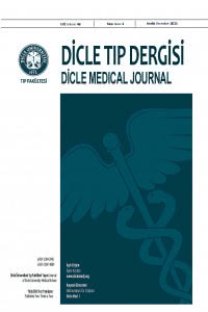Gestational diabetes mellitus diagnosed in different periods of gestation and neonatal outcome
Gebelik diyabeti ve yenidoğana etkisi
___
- 1. American diabetes association. Preconception care of women with diabetes mellitus. Diabetes Care 2003;26:S91-93.
- 2. Persson B, Hanson U. Neonatal morbidities in gestational diabetes mellitus. Diabetes Care 1998;21(suppl.2):B79–B84.
- 3. Kjos S, Buchanan T. Gestational diabetes mellitus. N Engl J Med 1999;341:1749-1756.
- 4. Langer O. Is normoglycemia the correct threshold to prevent complications in the pregnant diabetic patient? Diabetes Reviews 1996;4:2-10.
- 5. Farrell T, Neale L, Cundy T. Congenital anomalies in the offspring of women with type 1, type 2 and gestational diabetes. Diabet Med 2002;19:322-326.
- 6. Schaefer U, Songster G, Xiang A, Berkowitz K, Buchanan TA, Kjos SL. Congenital malformations in offspring of women with hyperglycemia first detected during pregnancy. Am J Obstet Gynecol 1997;177:1165-1171.
- 7. Metzger BE, Coustan DR. Summary and Recommendations of the Fourth International Workshop-Conference on Gestational Diabetes Mellitus. Diabetes Care 1998;21(suppl.2):B161-167.
- 8. Bartha J, Martinez P, Comino R. Gestational diabetes mellitus diagnosed during early pregnancy. Am J Obstet Gynecol 2000;182:346-350.
- 9. Meyer WJ, Carbone J, Gauthier DW, Gottmann DA. Early gestational glucose screening and gestational diabetes. J Reprod Med 1996;41:675-679.
- 10. Bartha JL, Martinez-Del-Fresno P, Comino-Delgado R. Early diagnosis of gestational diabetes mellitus and prevention of diabetes related complications. Eur J Obstet Gynecol Reprod Biol 2003;9:41-44.
- 11. National Diabetes Data Group. Classification: and diagnosis of diabetes mellitus and other categories of glucose intolerance. Diabetes 1979;28):1039-1057.
- 12. Gillmer MDG, Hurley PA. Diabetes and endocrine disorders in pregnancy. In: Edmonds DK, editor. Dewhurst’s Textbook of obstetrics and gynaecology for postgraduates. 6th ed. Oxford: Blackwell Science 1999. p. 197-209.
- 13. Goldstein SR. Embryonic ultrasonographic measurements: crown-rump length revisited. Am J Obstet Gynecol 1991;165:497-501.
- 14. Nasrat AA, Augensen K, Abushal M, Shalhoub JT. The outcome of pregnancy following untreated impaired glucose tolerance. Int J Gynaecol Obstet 1994;47:1-6.
- 15. Tan YY, Yeo GS. Impaired glucose tolerance in pregnancy – is it of consequence? Aust N Z J Obstet Gynaecol 1996 ;36:248-255.
- 16. Deerochanawong C, Putiyanum C, Wongsuryrat M, Serirat S, Jinayon P. Comparison of National Diabetes Data Group and World Health Organization criteria for detecting gestational diabetes mellitus. Diabetologia 1996;39:1070-1073.
- 17. Jacobson JD, Cousins L. A population-based study of maternal and perinatal outcome in patients with gestational diabetes. Am J Obstet Gynecol 1989;161:981-986.
- 18. Beischer NA, Oates JN, Henry OA, Sheedy MT, Walstab JE. Incidence and severity of gestational diabetes mellitus according to country of birth in women living in Australia. Diabetes 1991;40 (Suppl 2): 35-38.
- 19. Sermer M, Naylor CD, Farine D, et al. The Toronto Tri- Hospital Gestational Diabetes Project . A preliminary review. Diabetes Care 1998;21(Supplement 2):B33-42.
- 20. El-Shafei A, Bashmi Y, Norman A. Incidence and severity of gestational diabetes in Bahrain and Australia. Aus NZ J Obstet Gyneacol 1989;29:204-209.
- 21. Moses RG, Colagiuri S. The extent of undiagnosed gestational diabetes mellitus in New South Wales. Med J Aust 1997;167:14-16.
- 22. Berkowitz G, Roman S, Lapinski R. Maternal characteristics, neonatal outcome, and the time of diagnosis of gestational diabetes. Am J Obstet Gynecol 1992;167(4 pt 1):976-982.
- 23. Svare J, Hansen B, Molsted-Pedersen L. Perinatal complications in women with gestational diabetes mellitus. Acta Obstet Gynecol Scand 2001;80:899-904.
- 24.Super D, Edelberg S, Philipson E, Hertz R, Kalhan S. Diagnosis of gestational diabetes in early pregnancy. Diabetes Care 1991;14:288-294.
- 25. Moses RG, Griffiths RD. Can a diagnosis of gestational diabetes be an advantage to the outcome of pregnancy? J Soc Gynecol Investig. 1995;2:523-525.
- 26. Leipold H, Worda C, Gruber CJ, Kautzky-Willer A, Husslein PW, Bancher-Todesca D. Large-for-gestational-age newborns in women with insulin-treated gestational diabetes under strict metabolic control. Review Group(s): Cochrane Child Health Field, Cochrane Metabolic and Endocrine Disorders Group. Source: Wiener Klinische Wochenschrift 2005;117:521-525.
- 27. Malinowska-Polubiec A, Czajkowski K, Sotowska A. Pregnancy and delivery course in patients with gestational diabetes mellitus. Ginekol Pol 2003;74:1200-1207.
- ISSN: 1300-2945
- Yayın Aralığı: 4
- Başlangıç: 1963
- Yayıncı: Cahfer GÜLOĞLU
Tıp Fakültesi öğretim elemanlarının teknolojiye ilişkin tutumlarının CHAID analizi ile incelenmesi
Ömer SATICI, Zeki AKKUŞ, Aykut ALP
CÜNEYT ÖZDEN, CEVDET SERKAN GÖKKAYA, Özer GÜZEL, Tağmaç DEREN, Özdem Levent ÖZDAL, Ali MEMİŞ
Kırk beş yaş ve üstü kadınlarda osteoporoz risk faktörleri
Gül PINAR, Tevfik PINAR, Nevin DOĞAN, Azize KARAHAN, Lale ALGIER, Aysel ABBASOĞLU, Esra KUŞÇU
Chiari tip II olgusunda obstetrik ultrasonografi bulguları
ALPTEKİN TOSUN, Bekir Sıtkı BOZAN
gretim elemanlarının teknolojiye iliskin tutumlarının CHAID analizi ile incelenmesi
Ömer SATICI, Zeki AKKUS, Aykut ALP
Asitretin ile tedavi edilen bir Mal de Meleda Olgusu
Ekrem AKTAŞ, Pınar KULLUK, Serap UTAŞ, Servet KESİM
Gebelik diyabeti ve yenidogana etkisi
Aqueela AYAZ, Shazia SAEED, Mian Usman FAROOQ, Muhammad Luqman Ali BAHOO, Kashif HANİF
Beyin cerrahisi yoğun bakım ünitesi enfeksiyon etkenleri ve antibiyotik duyarlılıkları
Aslan GÜZEL, Gökhan AKTAŞ, M. Kemal ÇELEN, Mehmet TATLI, M. Faruk GEYİK, Mehmet ÖZEKİNCİ, Cemal ÜSTÜN, Ümit ÖZKAN, Ömer SATICI, Adnan CEVİZ
SNAPPE II score for predicting mortality in a level II neonatal intensive care unit
